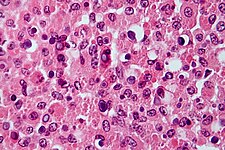Condition | Prothrombin time | Partial thromboplastin time | Bleeding time | Platelet count |
|---|---|---|---|---|
| Vitamin K deficiency or warfarin | prolonged | prolonged | unaffected | unaffected |
| Disseminated intravascular coagulation | prolonged | prolonged | prolonged | decreased |
| Von Willebrand disease | unaffected | prolonged | prolonged | unaffected |
| Haemophilia | unaffected | prolonged | unaffected | unaffected |
| Aspirin | unaffected | unaffected | prolonged | unaffected |
| Thrombocytopenia | unaffected | unaffected | prolonged | decreased |
| Early Liver failure | prolonged | unaffected | unaffected | unaffected |
| End-stage Liver failure | prolonged | prolonged | prolonged | decreased |
| Uremia | unaffected | unaffected | prolonged | unaffected |
| Congenital afibrinogenemia | prolonged | prolonged | prolonged | unaffected |
| Factor V deficiency | prolonged | prolonged | unaffected | unaffected |
| Factor X deficiency as seen in amyloid purpura | prolonged | prolonged | unaffected | unaffected |
| Glanzmann's thrombasthenia | unaffected | unaffected | prolonged | unaffected |
| Bernard-Soulier syndrome | unaffected | unaffected | prolonged | decreased |
Mechanism of action
Metoclopramide was first described by Dr. Louis Justin-Besançon and C. Laville in 1964.[6] It appears to bind to dopamine D2 receptors where it is a receptor antagonist, and is also a mixed 5-HT3 receptor antagonist/5-HT4 receptor agonist.
The anti-emetic action of metoclopramide is due to its antagonist activity at D2 receptors in the chemoreceptor trigger zone (CTZ) in the central nervous system (CNS)—this action prevents nausea and vomiting triggered by most stimuli.[7] At higher doses, 5-HT3 antagonist activity may also contribute to the anti-emetic effect.
The gastroprokinetic activity of metoclopramide is mediated by muscarinic activity, D2 receptor antagonist activity and 5-HT4 receptor agonist activity.[8][9] The gastroprokinetic effect itself may also contribute to the anti-emetic effect.
72 使用下列那一類治療憂鬱症的藥物時,必須限制含乳酪食品的攝取,否則會引起血壓上升的危險?
Fluoxetine Imipramine Bupropion Tranylcypromine
ANS D
Foods high in endogenous monoamine precursors or exogenous monoamine compounds may cause adverse reactions. The most common example of this, is the hypertensive crisiscaused by the ingestion of tyramine, which is found in foods like aged cheeses, cured meats, tofu and certain red wines. Some, such as yeast extracts, contain enough tyramine to be potentially fatal in a single serving. Spoiled food is also likely to contain dangerous levels of tyramine.
Tranylcypromine (Parnate, Jatrosom) is a drug of the substituted phenethylamine and amphetamine classes which acts as amonoamine oxidase inhibitor (MAOI)—it is a non-selective and irreversible inhibitor of the enzyme monoamine oxidase (MAO).[1][2] It is used as an antidepressant and anxiolytic agent in the clinical treatment of mood and anxiety disorders, respectively.
:毒蕈素性受體阻斷作用: MUSCARINIC RECEPTOR BLOCKER
- Use of NSAIDs or drugs with anticholinergic properties.THIS CAUSE URINE RETENTION
Goodpasture’s syndrome (also known as Goodpasture’s disease and anti-glomerular basement antibody disease) is a rare disease characterized by glomerulonephritis and hemorrhaging of the lungs.[1] Although many diseases can present with these symptoms, the name Goodpasture’s syndrome is usually reserved for the autoimmune disease triggered when the patient’s immune system attacks Goodpasture antigen (a type II hypersensitivity reaction[2]), which is found in the kidney and lung, and in time, causing damage to these organs. The disease bears the name of the American pathologist Dr. Ernest Goodpasture of Vanderbilt University, whose 1919 description is regarded as the first report on the existence of the condition.[3][4]
The GBM antigen responsible for this disease is a component of the non-collagenous domain (NC1) of the alpha-3 chain of collagen type IV.
Malakoplakia
| Malakoplakia | |
|---|---|
| Classification and external resources | |
 Micrograph showing the characteristic finding of malakoplakia (Michaelis-Gutmann bodies). H&E stain. | |
| DiseasesDB | 29128 |
| eMedicine | derm/872 |
| MeSH | D008287 |
Malakoplakia is a rare inflammatory condition which makes its presence known as a papule, plaque or ulceration that usually affects thegenitourinary tract.[1]:274 However, it may also be associated with other bodily organs. It was initially described in the early 1900s as soft yellowish plaques found on the mucosa of the urinary bladder. Microscopically it is characterized by the presence of foamy histiocyteswith basophilic inclusions called Michaelis-Gutmann bodies.
It usually involves gram negative bacteria.[2]
[edit]Causes
Malakoplakia is thought to result from the insufficient killing of bacteria by macrophages. Therefore, the partially digested bacteria accumulate in macrophages and leads to a deposition of iron and calcium. The impairment of bactericidal activity manifests itself as the formation of an ulcer, plaque or papule.
Malakoplakia is associated with patients with a history of immunosuppression due to lymphoma, diabetes mellitus, renal transplantation, or because of long-term therapy with systemic corticosteroids.
No comments:
Post a Comment